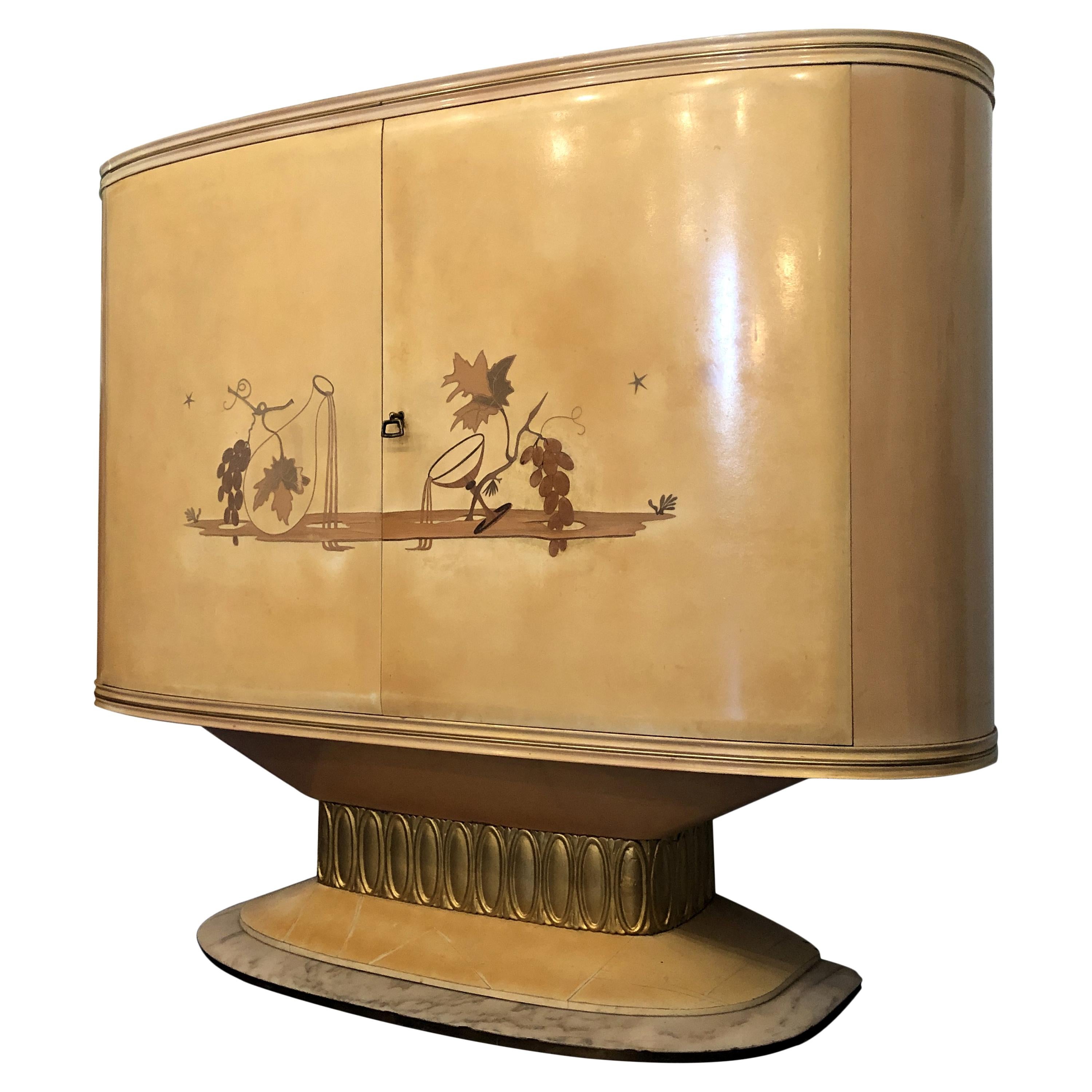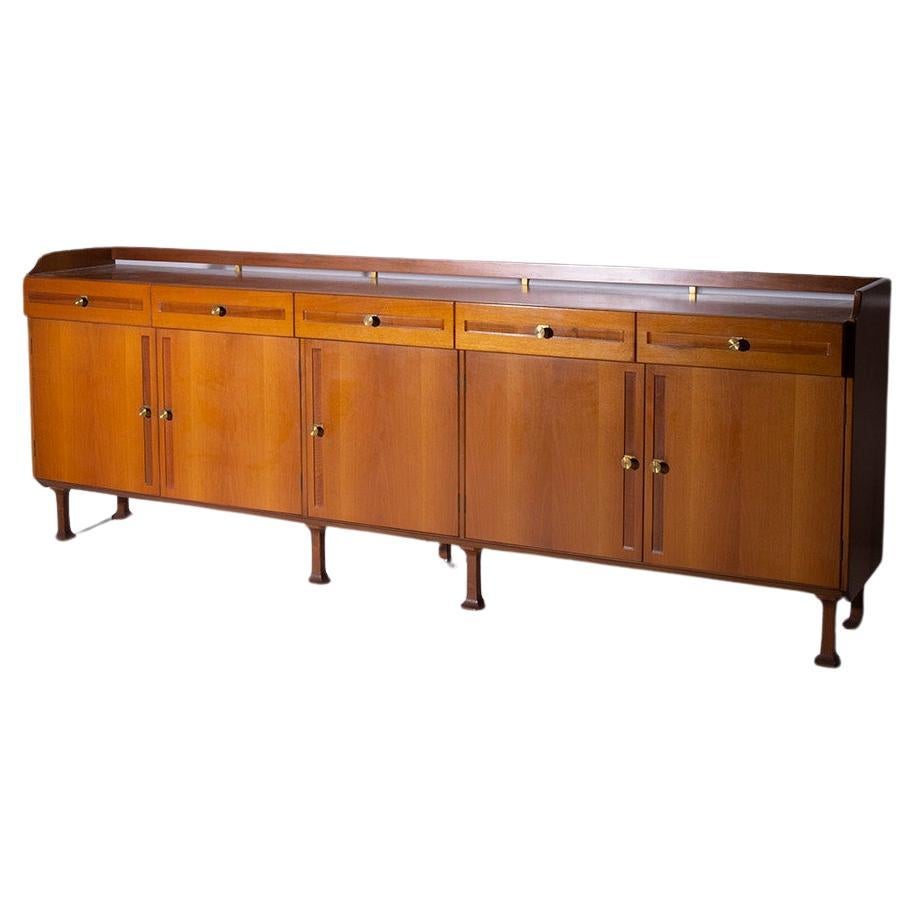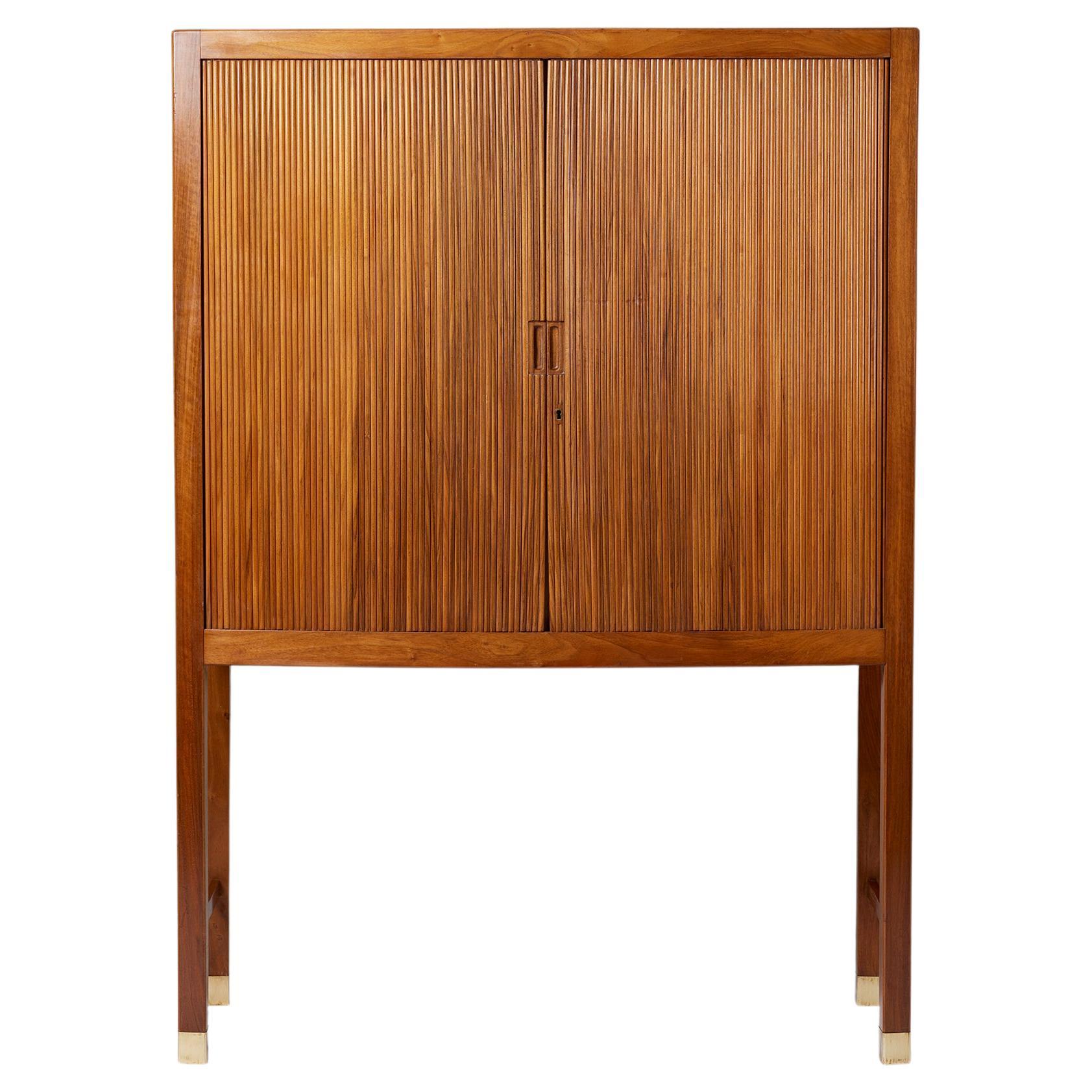Items Similar to Galleria Mobili d'Arte Cantù Sideboard in Wood with Doors and Drawers 1950s
Want more images or videos?
Request additional images or videos from the seller
1 of 11
Galleria Mobili d'Arte Cantù Sideboard in Wood with Doors and Drawers 1950s
About the Item
Wooden sideboard with three storage units (two larger and one small) and three frontal drawers with a structure entirely realized in wood and brass details (keys and feet).
Manufactured by Galleria Mobili d'Arte in Cantù, Italy, during the 1950s.
Commissioned by S. Apollonia Srl, Galleria Mobili d’Arte is, in the chronological order, the first of the new exhibition buildings designed to house the furniture made by craftsmen shops from Cantù.
Built with a traditional structure in concrete and masonry, the building is characterized by low windows that, running along all the sides, give a strong horizontal character, and by the curvilinear corner interrupted by the large window of the stairs. The same building was recently renovated, with changes also outside, and completely dedicated to offices.
?
- Creator:Galleria Mobili d'Arte (Manufacturer)
- Dimensions:Height: 47.25 in (120 cm)Width: 114.18 in (290 cm)Depth: 18.12 in (46 cm)
- Style:Mid-Century Modern (Of the Period)
- Materials and Techniques:
- Place of Origin:
- Period:
- Date of Manufacture:1950s
- Condition:Wear consistent with age and use.
- Seller Location:Montecatini Terme, IT
- Reference Number:1stDibs: LU5304231145212
About the Seller
4.9
Gold Seller
These expertly vetted sellers are highly rated and consistently exceed customer expectations.
1stDibs seller since 2020
102 sales on 1stDibs
Typical response time: <1 hour
- ShippingRetrieving quote...Ships From: Borgo a Buggiano, Italy
- Return PolicyA return for this item may be initiated within 7 days of delivery.
More From This SellerView All
- Giotto Stoppino Sheraton Sideboard in Black Lacquered Wood by Acerbis 1977By Acerbis, Giotto StoppinoLocated in Montecatini Terme, ITSheraton sideboard presents two sliding doors that slide outward to expose three inner storage units with glass shelves and four drawers on the central part. The sideboard has a str...Category
Vintage 1970s Italian Mid-Century Modern Sideboards
MaterialsLaminate, Wood, Ash
- Vico Magistretti Black CS49 Samarcanda Black Chest of Drawers by Poggi 1970sBy Vico Magistretti, PoggiLocated in Montecatini Terme, ITChest of drawers model CS49 with four frontal drawers and four doors revealing inner shelves with structure in black lacquered wood and top upholstered with black skai or faux leather. Designed by Vico Magistretti and produced by Poggi in 1970s Ludovico Magistretti was born in Milan on 6 October 1920. He went to Parini High School and in autumn 1939 enrolled in the Faculty of Architecture at the Royal Polytechnic in Milan. After 8 September 1943, to avoid being deported to Germany, he left Italy during his military service and moved to Switzerland, where he took some academic courses at the Champ Universitaire Italien in Lausanne, taught at the local university. During his stay in the Swiss city he met Ernesto Nathan Rogers, the founder of the BBPR firm who had taken refuge in Switzerland after racist laws were passed in Italy. This was a key encounter in Magistretti’s intellectual and professional development, since the architect from Trieste turned out to be his maestro. He returned to Milan in 1945, where he graduated in Architecture at the Polytechnic on 2 August. He then immediately began his career working with the architect Paolo Chessa at the firm owned and run by his father, who died prematurely that same year. Here, in his father’s small firm, he spent his entire career in partnership with Franco Montella. During reconstruction operations in Milan from 1949-59, Magistretti designed and constructed about 14 projects for INA-Casa in conjunction with other architects. He was involved with Mario Tedeschi in the joint project for the QT8 neighbourhood, designing houses for veterans from the African campaign and also Santa Maria Nascente Church. In 1946 he participated in the R.I.M.A. exhibition (Italian Assembly for Furniture Exhibitions), held at the Palazzo dell’Arte, designing some small almost self-made pieces of furniture and then, in 1947 and 1948, he took part together with Castiglioni, Zanuso, Gardella, Albini and others in the exhibitions organized by Fede Cheti, a furniture fabric maker, held at her own workshop. The young architect was involved in plenty of activities and came up with lots of new ideas and proposals in the 1950s. Over the following years he also designed a number of other important projects, including the Towers in piazzale Aquileia (1961-64), Bassetti House in Azzate (1960-62), Cassina House in Carimate (1964-65), and the house in via Conservatorio in Milan (1963-66). In 1956 he was one of the founding members of the ADI, Industrial Design Association, and during the same year he was a member of the panel of judges for the Golden Compass Award for the first time. His work as an architect was almost totally focused on the issue of housing and living from the 1960s onwards, as he developed his own extremely expressive idiom, which, even though it was heavily criticised at times, made a real impression on the architectural scene in Lombardy during that period, making him one of its leading figures. This is the context in which he took part in the CIAM Congress (International Modern Architecture Congress) held in Otterlo in the Netherlands in 1959, during which the Italians presented Velasca Tower designed by the BBPR, the Olivetti canteen designed by Ignazio Gardella, Arosio house designed by Vico Magistretti (1956-59), and the houses in Matera designed by Giancarlo De Carli...Category
Vintage 1970s Italian Post-Modern Commodes and Chests of Drawers
MaterialsFaux Leather, Wood
- Pier Luigi Colli Large Sideboard in Wood with Drawers Italian Manufacturer 1930sBy Pier Luigi ColliLocated in Montecatini Terme, ITLarge sideboard is entirely realized in oak wood, with four drawers on each side (for a total of eight drawers) and a central storage unit. Designed by Pier Luigi Colli Italian Manufacture from 1938 ca. To reconstruct the story of Pier Luigi Colli, we must take a leap back to the 19th century in Turin, a multifaceted city, in some ways controversial due to its austere and sometimes introverted character, but at the core of a creative drive: and if it is primarily known for its automobile industry, there was a time when Turin was at the height of fame also in the field of furniture and embroidery, thanks to the presence of two entrepreneurial realities. On the one hand there was the MIRAM (Italian Hand-Made Embroidery Manufacture) founded by Pietro Colli in 1850, specializing in gobelin fabrics and bandera embroideries. His daughter Teresa traveled between Italy and Paris to discover the latest trends in fabrics and embroidery, while her younger brother, Pier Luigi Colli (1895-1968), the star of this story, joined the company in 1921. Distinguishing himself for his enterprising personality and willing to continue his father's profession, Pier Luigi was known to his contemporaries as "the artist interior designer", and had no doubts about his future: he moved temporarily to Paris, where he attended L'Ecole des Beaux Arts Décoratives. The other great Turin manufacturer to be mentioned is Martinotti, founded in 1931 by Giuseppe Martinotti and supplier of fine furnishings for the Savoy court, pieces which were characterized by a typically 19th century eclectic style, generally made of exotic woods featuring ivory and tortoiseshell inlays: at that time, Martinotti represented the top of internationality, having even participated in the 1875 Philadelphia exhibition! The two brands' fate merged in 1902, a decisive year for Turin which, hosting the International Exhibition of Modern Decorative Art, became the cradle of the spread of the Liberty style in Italy. In the exhibition, Martinotti exhibited an elegant interior, in which all the textile parts, from the curtains to the seat upholstery, was made by Colli. It was in 1926 that Colli (MIRAM) finally acquired Martinotti, founding a laboratory where, from the savoir faire of the two companies, complete pieces of furniture were created and tailor-made for the customer, from the structure to its upholstery. Meanwhile, Pier Luigi Colli was living in Paris, the ideal place to be in 1925, when the International Exhibition of Modern Decorative and Industrial Arts brought him closer to the work of one of his putative fathers, the great French cabinet maker Jacques-Émile Ruhlmann (Paris, 1879 - 1933). Thanks to Paris, Pier Luigi intertwined contacts with the international beau monde, he started to import Lalique glass from France, while the Colli's clientele expanded and special commissions arrived, such as the creation of the Royal Train of the Savoy family made with Fiat, or the lecture hall in the University of Turin. The success of a brand is also measured by its openness to establishing collaborations with the great designers of its time, in the case of Colli resulting in important creative partnerships: from Gio Ponti, who relied on the brand for his Richard Ginori project in Rome, up to Carlo Mollino, who created with Colli the handrails of the RAI (national TV) auditorium and the windows of the Teatro Regio in Turin; also in Turin, the Morbelli architects collaborated with Colli for the furnishings of the RAI skyscraper, and the architects Gabetti Isola for the interiors of the Stock Exchange in Turin. In the 40s and 50s, having opened a branch in Rome, Colli was at the peak of productivity. The embroidery and textile section continued to be one of its strengths, keeping alive the relations with France and its great masters: among the inspirations were the geometric shapes of the fabrics of Ruhlmann's interiors, or the tactile carpets made by designer Mariod Dorn. And so, another Colli trademark become the "textured carpet...Category
Vintage 1930s Italian Mid-Century Modern Sideboards
MaterialsWood, Oak
- Console Table in Black Lacquered Wood and Pink Marble Italian Manufacture 1950sLocated in Montecatini Terme, ITA Mid-Century Modern style console table with a structure in black lacquered wood and a tabletop in pink marble. The console table presents a single drawer on the frontal part. ...Category
Vintage 1950s Italian Mid-Century Modern Console Tables
MaterialsMarble
- Gio Ponti Set of Two Stools in Black Lacquered Wood and Fabric 1950s ItalyBy Gio PontiLocated in Montecatini Terme, ITSet of two stools with legs in black lacquered wood and seats upholstered in light blue fabric. Attribuited to Gio Ponti, Italian Manufacture 1950s Gio Ponti was an icon of the m...Category
Vintage 1950s Italian Mid-Century Modern Stools
MaterialsFabric, Wood
- Gio Ponti Coffee Table in Wood and Glass by Figli di Amedeo Cassina 1950sBy Figli di Amadeo Cassina, Gio PontiLocated in Montecatini Terme, ITCoffee or occasional table with structure in wood a removable center part in sheet metal and a rectangular shaped table top designed by Gio Ponti and produced by Figli di Amedeo Cassina...Category
Vintage 1950s Italian Mid-Century Modern Coffee and Cocktail Tables
MaterialsMetal
You May Also Like
- Gigantic cabinet by Galleria Mobili D'Arte - CantuLocated in Beverly Hills, CAGigantic sideboard manufactured by Galleria Mobili d'Arte in Cantù, Italy, during the 1950s. Constructed of teak wood, metal with brass - Original label All 5 doors open to reveal ...Category
Vintage 1950s Italian Cabinets
MaterialsMetal, Brass
- Swedish 1810s Painted Wood Clock Cupboard with Doors and DrawersLocated in Atlanta, GAA Swedish painted wood clock cabinet from the early 19th century, with distressed finish, doors and drawers. Created in Sweden during the early years of the 19th century, this painte...Category
Antique Early 19th Century Swedish Cupboards
MaterialsWood
- Art Deco Lacquered Wood Parchment Bar Cabinet, Galleria Mobili Cantù Italy, 1950Located in Traversetolo, ITRare Art Deco wet bar in lacquered wood parchment from galleria mobili d'arte cantù, Italy 1950. Elegant movement of the lines on the front inlays on ...Category
Vintage 1950s Italian Art Deco Cabinets
MaterialsAsh, Glass, Wood
- Art Deco Lacquered Wood Parchment Bar Cabinet, Galleria Mobili Cantù Italy, 1950By Galeria Mobili d´Arte CantùLocated in Traversetolo, ITRare Art Deco wet bar in lacquered wood parchment from Galleria Mobili d'Arte Cantù, Italy, 1950. The elegant movement of the lines on the front inlay...Category
Vintage 1950s Italian Art Deco Cabinets
MaterialsWood, Glass, Ash
- Vintage Italian sideboard by Mobili d'arte Cantù, with labelBy Galeria Mobili d´Arte CantùLocated in Milano, ITIn the world of vintage furniture, there exists a magnificent Italian sideboard, a true treasure from the 1950s, bearing the prestigious label of Mobili di Cantù. This sideboard is n...Category
Vintage 1950s Italian Mid-Century Modern Credenzas
MaterialsBrass
- Cabinet with Tambour Doors Designed by a Danish Cabinetmaker, Denmark, 1950sLocated in Stockholm, SECabinet with tambour doors designed by a Danish Cabinetmaker, Denmark, 1950s. Walnut and brass. H: 140 cm W: 100 cm D: 44 cmCategory
Vintage 1950s Danish Mid-Century Modern Cabinets
MaterialsBrass
Recently Viewed
View AllMore Ways To Browse
Wood 1950s
Italian D
D Vintage Kitchen
Retro Sideboard With Drawers
Used Shop Doors
Wood Sideboard With Drawers
Three Door Sideboard
Shop Doors
Vintage Wooden Doors Doors
Vintage Wooden Door Doors
Small Brass Cabinet With Doors
D Century Sideboard
Wood Door House
Sideboard With Key
Used Doors With Windows
1950s Italian Drawers
Wooden Sideboard
Corner Built In





